M/Y Grace Galapagos Itinerary
Galapagos Yacht Itinerary: M/Y Grace
M/Y Grace is a live aboard yacht, specializing in tours of the Galapagos Islands.
Guests of the Grace will enjoy two landings each full day in the National Park along with snorkeling outings and opportunities for sea kayaking and panga rides, all led by a top notch National Park Guide.
Those looking for details on the vessel itself can find them here:
For those interested in a detailed itinerary for M/Y Grace’s group-basis Galapagos tours, it can be found below.

DAY 1 – SATURDAY
AM: San Cristobal Island
PM: Isla Lobos
ACTIVITIES: Walks and Hikes , Snorkeling and Panga Ride
You’ll need to rise early this morning to catch your flight to the Galapagos.
All our flights to the Galapagos originate in Quito and stop briefly in the port city of Guayaquil to take on passengers before heading on to the islands.
For this itinerary you will be landing on the island of San Cristobal.
Galapagos National Park
After passing through Galapagos National Park inspection your National Park Guide will be there to greet you.
They’ll be holding a sign with the name of your yacht and will accompany you on the short bus ride to the waterfront.
San Cristobal
San Cristobal was the first island Darwin visited when he arrived in 1835.
He reported encountering a pair of giant tortoises feeding on cactus during that outing.
Today the airport of this easternmost island in the chain is increasingly used as the arrival point for flights into and out of the Galapagos.
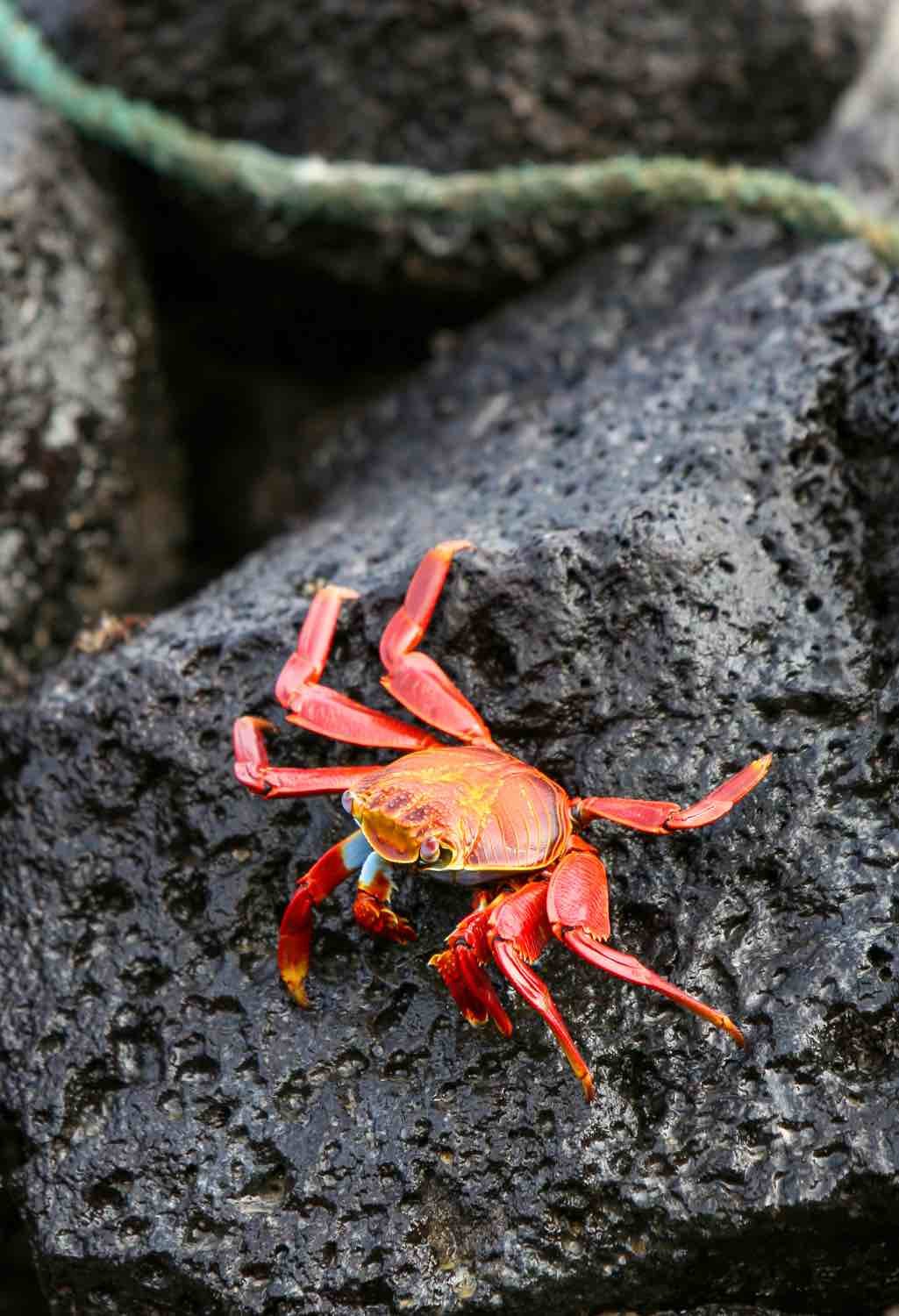
In 1998 the Galapagos National Park Visitor Centre opened for the benefit of islanders and travelers alike, presenting a comprehensive exhibit of San Cristobal’s unique:
- Natural History
- Human Interaction
- Ecosystems
- Flora
- Fauna
The Galapagos National Park Visitor Centre also hosts interesting cultural activities, including theatre, exhibitions and workshops.
From the Interpretation Center, a short trail arrives at Frigate Bird Hill, where both “magnificent-frigates” and “great-frigates” can be seen in the same colony—ideal for learning to distinguish the two bird species.
If your crew requires a bit more time to prepare the Grace we may take in the Visitor Center before heading to the dock.
Boarding the M/Y Grace
At the dock we board a dinghy (panga) to make the short crossing to the M/Y Grace.
You only need to bring your carryon luggage aboard the panga as our crew will transfer your luggage to your cabin.
You’ll have time to settle into your new home for the week before assembling on deck to review safety procedures and coming events with your Galapagos National Park Guide.
Departing San Cristobal
During this introduction, the Grace will start her engines and set out to the first landing site.
Heading up the coast from Wreck Bay and Puerto Baquerizo Moreno, in the distance we’ll have a glimpse of Lion Dormido.
Also known as Kicker Rock, Lion Dormido is a spectacular formation, rising 152 meters (500 feet) out of the Pacific.
Isla Lobos
To the southeast of Kicker Rock lies Isla Lobos. The tiny island is separated from much larger San Cristobal by a narrow channel and little bay.
This basalt island outcropping lives up to its name of Sea Lion Island, and is home to a noisy population of frolicking and barking beasts.
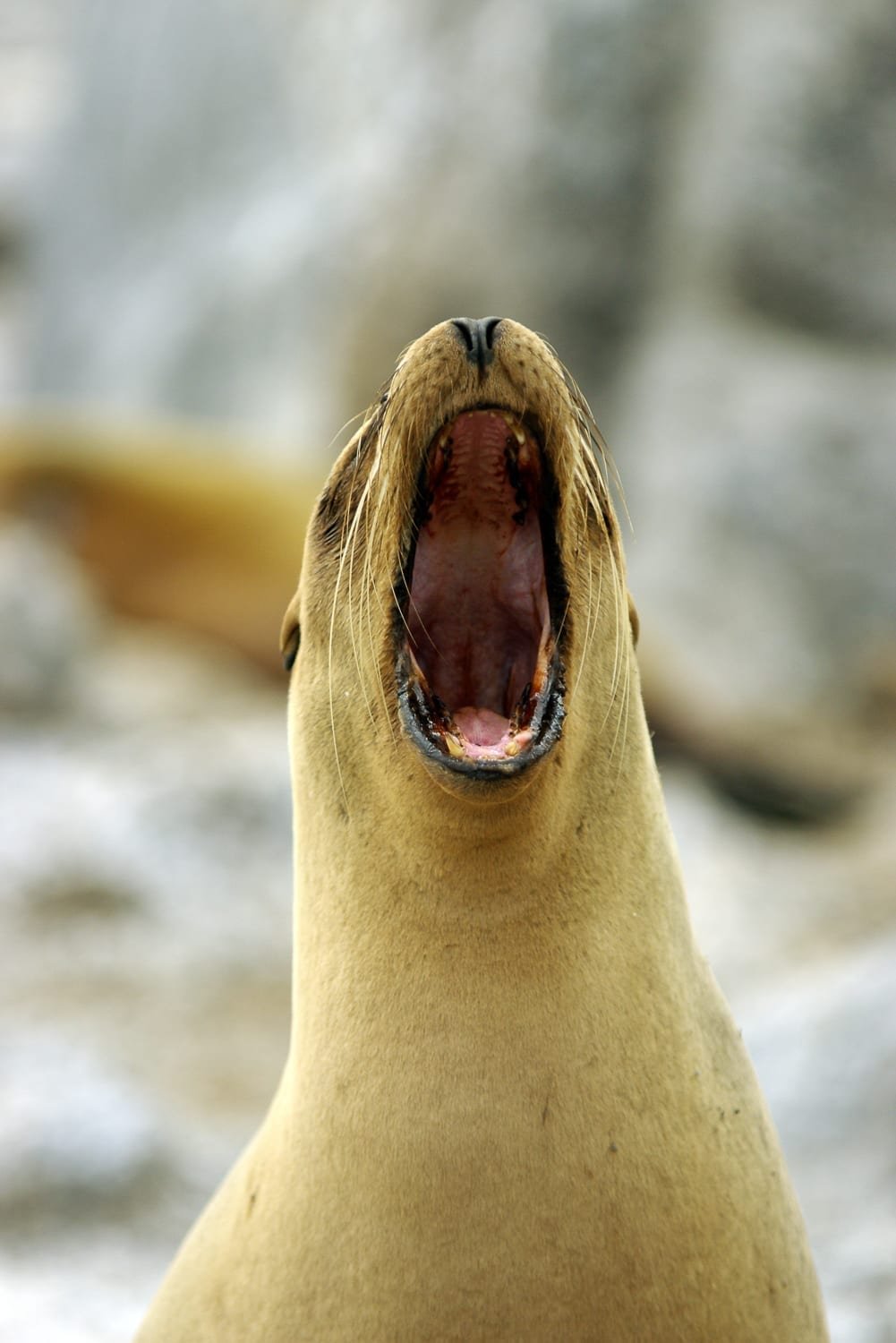
Isla Lobos is also a nesting place for blue-footed boobies and an excellent spot for snorkeling with sea lions.
After walking the trail for some baby sea lion and booby watching amidst the sands beneath the salt bushes we have a real treat in store.
Swimming with Sea Lions
We change into our snorkeling gear for some swimming with sea lions!
The sea lions like to dart past, and then swim up to you to blow bubbles at your mask.
On occasion they have been known to leap over, and then dive in front of unsuspecting snorkelers.
Following our snorkeling outing you will discover that the best place to warm up from your dip is in Grace’s Jacuzzi.
Our afternoon comes to a close as we head south back to Puerto Baquerizo Moreno.
HAPPY, HOUR AND TOMORROW’S BRIEFING
We’ll enjoy our first Pacific sunset aboard the M/Y Grace by celebrating happy hour atop her sky lounge where drinks are available daily along with hors d’oeuvres.
A little later we gather in the main salon for a presentation by our guide on the next day’s activates and visitor sites, before sitting down to dinner.
We spend a bit more time in port this evening before setting sail for the oldest island in the Galapagos in the southeast of the archipelago.
Day 1 at a Glance
Morning: Fly to San Cristobal in the Galapagos Islands and board M/Y Grace.
Type of Landing: N/A
Late Afternoon: Lobos Island
Type of Landing: Wet
Other Activities: Snorkeling, Panga Ride & Hikes
Meals: Lunch, & Dinner
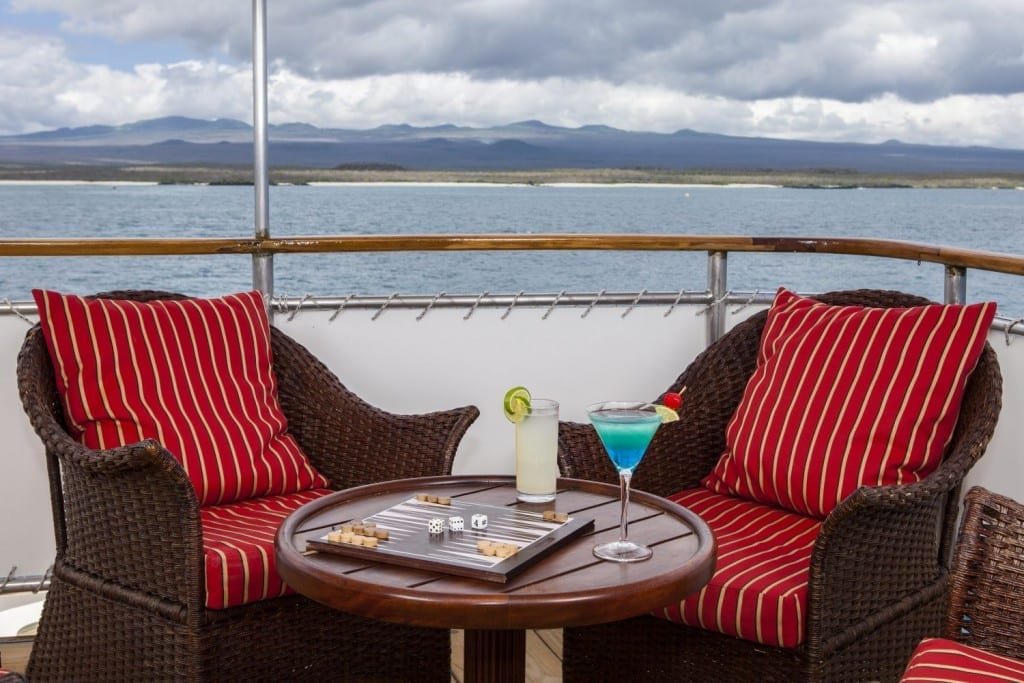
DAY 2 – SUNDAY
AM: Punta Suarez
PM: Gardner Bay, Gardner Islet
ACTIVITIES: Snorkeling, Walks and Hikes, Panga Rides and Kayaking
Hood is the southernmost island of the Galapagos archipelago.
It is one of the most popular, due to the breathtaking variation and sheer number of fauna that greet visitors along with well-known Gardner Bay.
The giant tortoise was reintroduced to Hood in the 1970’s and counts as one of the park’s great success stories.
While they reside in an off-limits area, there’s no need to worry—the famous giant tortoise awaits you on other islands!
Punta Suarez
The quantity and variety of wildlife at Punta Suarez is remarkable.
Sea lions surf the waves beyond the breakwater landing, and tiny pups are known to greet your toes upon arrival.
A few steps inland, you’ll find a colorful variety of marine iguana; endemic to the Galapagos.
These mystical creatures bear distinctive red and black markings, some with a flash of turquoise running down their spine.
Masked and Blue-Footed Boobies
The trail then takes us beside the western edge of the island where masked boobies (also known as Nazca boobies) nest along the cliff’s edge.
The trail descends to a rocky beach before rising to an open area where you may see a large gathering of nesting blue-foot boobies.
Galapagos doves, cactus finch and mocking birds forage nearby, unconcerned by human presence.
Both lava and swallow-tailed gulls, with their red ringed eyes, sit atop the cliffs in company with marine iguanas.
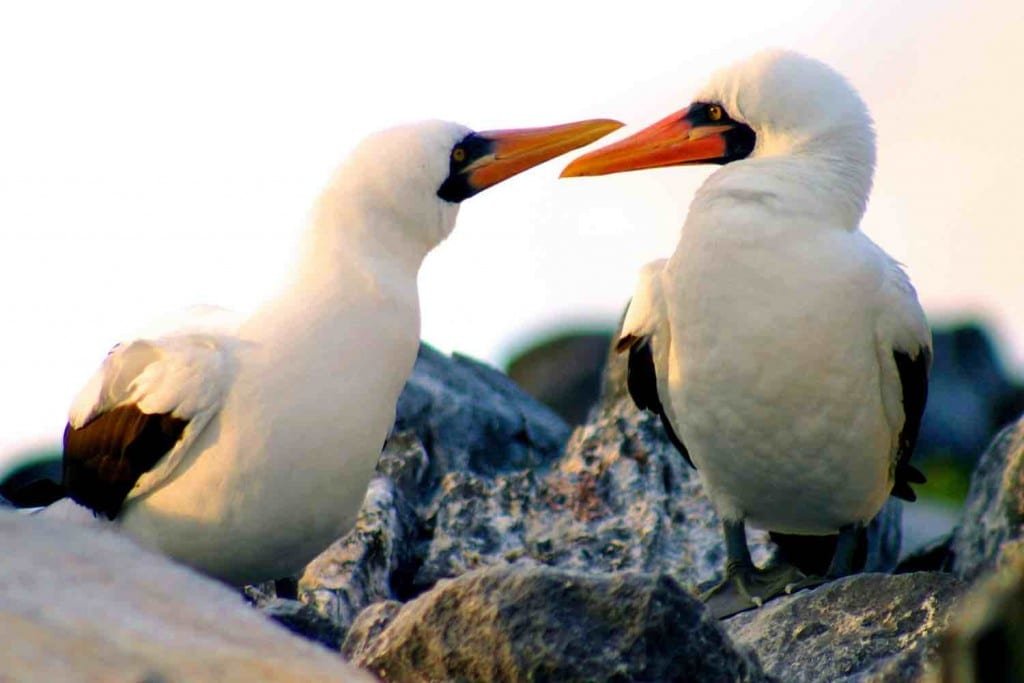
The trail continues to the high cliff edge of the southern shore.
Below, a shelf of black lava reaches out into the surf where a blowhole shoots a periodic geyser of salt water into the air.
Albatross Airport
Further east along the cliff is the Albatross Airport where waved albatross line up to launch their great winged bodies from the cliffs.
The waved albatross are the largest birds you will see in the Galapagos with wingspans up to 2.25 m or 7.4 ft.
They are the only species of albatross exclusive to the tropics. In the trees set back from the cliff is one of only two places in the world where the waved albatross nests.
The 12,000 pairs that inhabit Hood Island comprise all but a tiny fraction of the world’s population of this species.
Lucky visitors can watch courtship ‘fencing’ done with great yellow beaks. Large, fluffy, perfectly camouflaged chicks adorn nests on the ground nearby.
The Albatross lay their eggs from April through June though they can be seen fencing long after that. Eggs take two months to hatch.
Gardner Bay
On the northeastern shore of Hood, Gardner Bay offers a magnificent long white sandy beach, where colonies of sea lions laze in the sun, sea turtles swim offshore and inquisitive mockingbirds boldly investigate new arrivals.
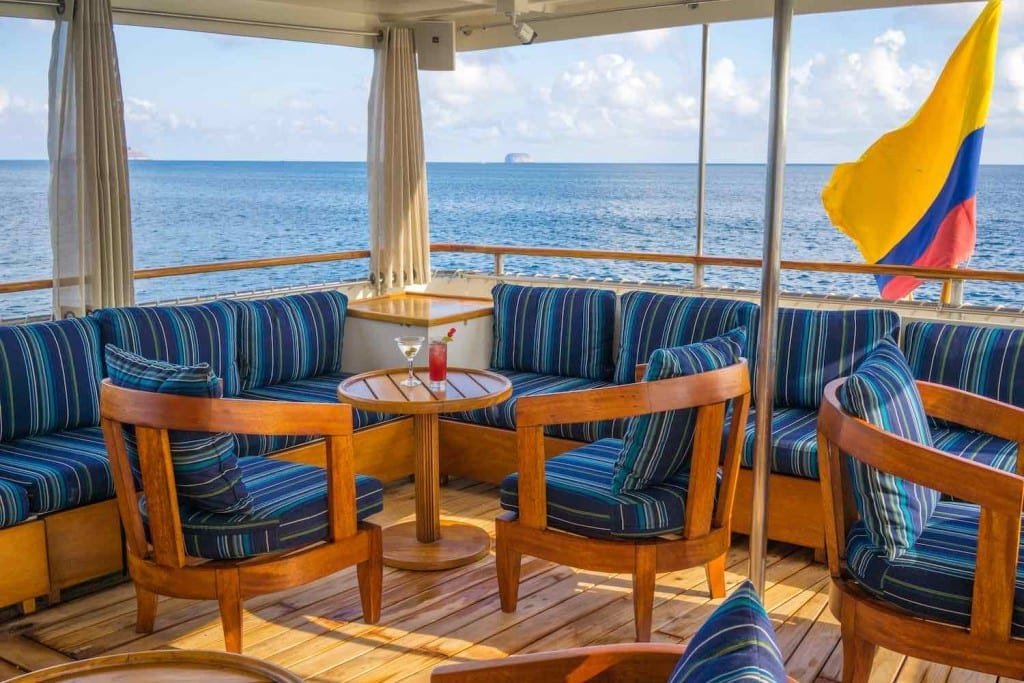
You will likely be lured from the powdery white sand into the turquoise water for a swim.
Gardner Island Snorkeling
Just a little further off-shore, the snorkeling by Gardner Island offers peak encounters with playful young sea lions and schools of surprisingly large tropical fish, including:
- Yellow-Tailed Surgeonfish
- King Angelfish
- Bump-Head Parrot Fish
The young sea lions like to snack and play along Gardner Island’s sea cliff.
They dart up from the depths, playfully show off their skills and then disappear. Sleepy white-tipped reef sharks can also be seen napping on the bottom.
Gardner Bay and Islet also offer inviting waters for those interested in kayaking.
For all who visit here, Española is a highlight of the Galapagos.
DAY 2 AT A GLANCE
Morning: Punta Suarez
Type of Landing: Dry
Level of Walk: Difficult
Other Activities: Nature Hikes
Afternoon: Gardner Bay, Gardner Islet
Type of Landing: Wet
Level of Walk: Easy
Other Activities: Nature Hikes, Snorkeling, Panga Ride & Kayaking
Meals: Breakfast, Lunch, & Dinner

DAY 3 – MONDAY
AM: Post Office Bay
PM: Punta Cormorant & Champion Islet
ACTIVITIES: Snorkeling, Walks & Hikes
Floreana has had a colorful history.
Pirates, whalers, convicts and a small band of somewhat peculiar colonists—a self proclaimed Baroness among them—who chose a Robinson Crusoe existence that ended in death and mystery.
Today roughly a hundred Ecuadorians inhabit Isla Floreana.
Floreana Post Office
In 1793 British whalers set up a barrel as the island’s post office, to send letters home on passing ships.
The tradition continues to this day, simply by dropping a post card into the barrel without a stamp.
The catch is you must take a post card from the barrel and see that it gets to the right place.
Continuing a bit farther inland you will have the opportunity to enter the underworld of Floreana in the form of a lava tube.
The lava tube descends fairly deep into the earth back toward the ocean, where you can swim in a subterranean grotto beneath the tide. Those interested in this activity should bring a good waterproof flashlight.
Snorkeling in Post Office Bay offers choice encounters with waiting sea turtles and tropical fish.
Our next landing is further along the shore to the east. On route we pass within view of Baroness Point in an area of mangrove lined lagoons.
Eloise Wehrborn de Wagner-Bosquet, the self proclaimed Baroness (of Floreana) frequented this overlook, but we will leave the rest of her intriguing story to your Galapagos guide.
Punta Cormorant
Punta Cormorant offers two highly contrasting beaches; the strand where we land is composed of volcanic olivine crystals, giving it a greenish tint that glitters in the sun.
From here you’ll notice the small cinder cone that forms the point.
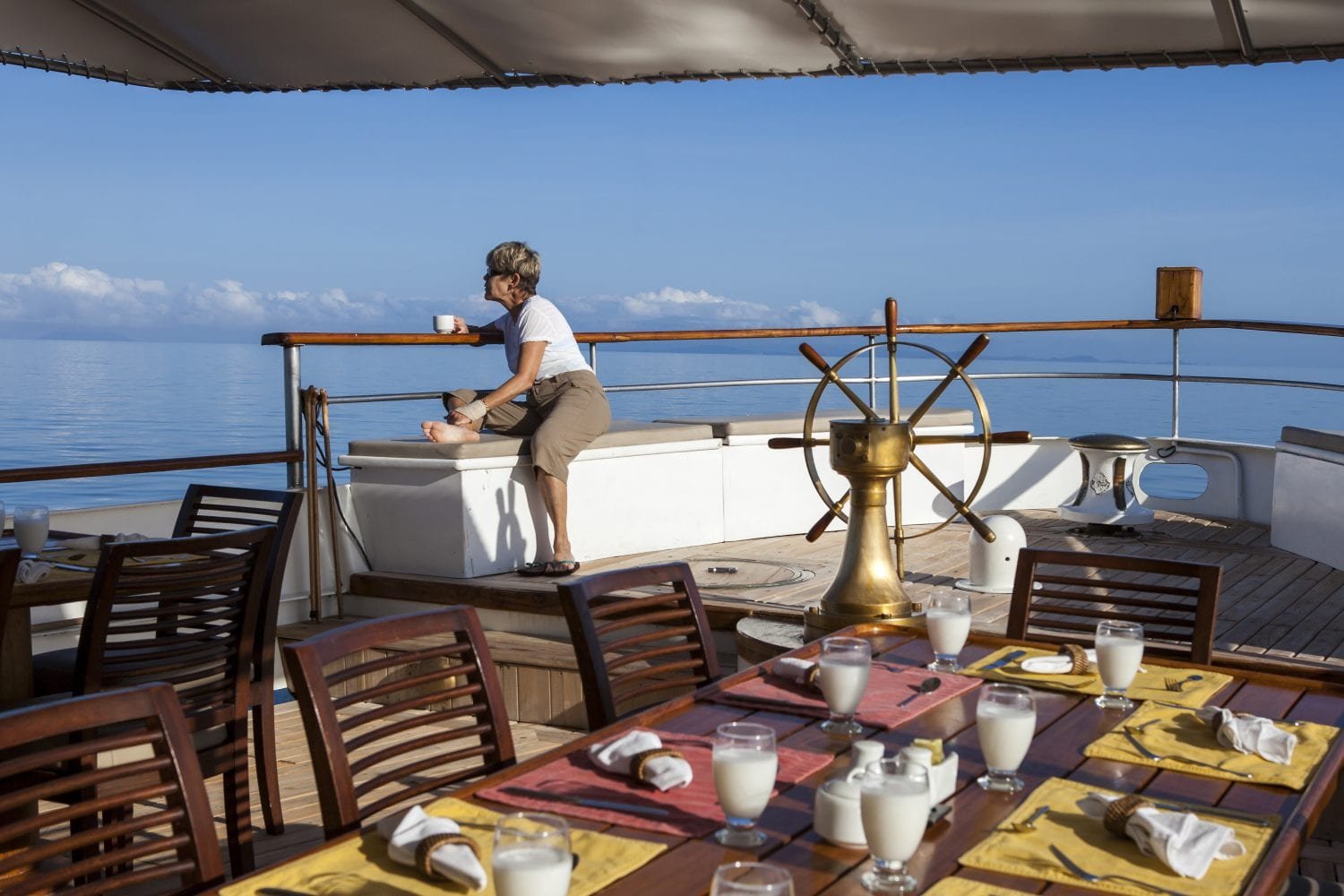
Our landing is just to the west of the cinder cone where a trail crosses the neck of an isthmus to a beach of very fine white sand known as Flour Beach.
Flour Beach
Flour Beach was formed by the erosion of coral skeletons.
Between the two beaches, in a basin formed by the surrounding volcanic cones, is a hyper-saline lagoon frequented by flamingoes, pintails, stilts and other wading birds.
We will stop at the lagoon before continue on the trail to Four Beach.
Be careful not to wade into the tide with bare feet! If you stand at the edge of the water and look into the tidal area you will soon notice that the silty surf is rife with rays.
Sea turtles also surf the waves off Flour Beach.
Snorkeling Champion Islet
We return to Grace and set out to our snorkeling destination in our wetsuits, while making our way around Punta Cormorant.
Not far from the north shore of Floreana is the tiny islet known as Champion.
Champion is considered one of the top snorkeling sites the Galapagos offering prime underwater sea lion interactions.
Dolphins and Exotic Fish
Dolphins are frequently seen near the shore along with humpback whales who like the bay off Flour Beach.
As you swim with the sea lions you will be surrounded by an assortment of tropical fish including yellowtail grunts, amberjacks and schools of king angel.
You may also spot sleepy white-tipped reef sharks hugging the bottom.
Sea turtles glide by, while torpedo-like Galapagos penguins can also be encountered in the waters off Champion.
DAY 3 AT A GLANCE
Morning: Post Office Bay
Type of Landing: Wet
Level of Walk: Easy
Other Activities: Nature Hikes & Snorkeling
Late Afternoon: Punta Cormorant
Type of Landing: Wet
Level of Walk: Moderate
Other Activities: Nature Hikes & Snorkeling
Meals: Breakfast, Lunch, & Dinner
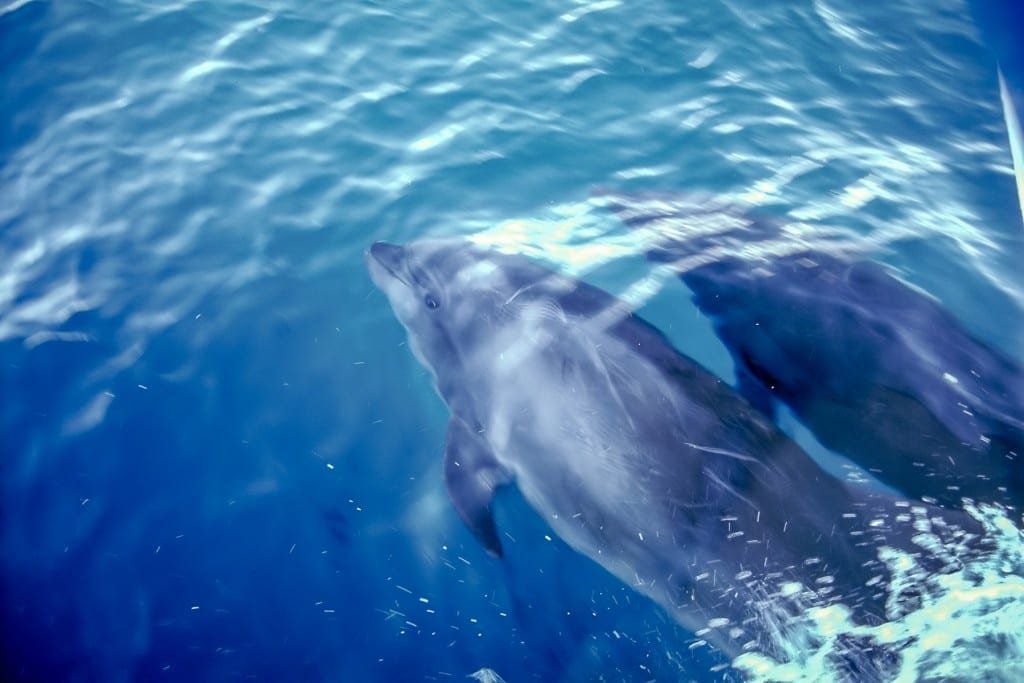
DAY 4 – TUESDAY
AM: Darwin Station / Puerto Ayora
PM: Highlands
ACTIVITIES: Walks & Hikes
Santa Cruz, our next stop, is the second largest island in the Galapagos and something of a hub for the archipelago.
Baltra, where one of the archipelago’s two airports is found, is on the far north end of the island.
Located in the south of this large, round volcanic island, you’ll find Puerto Ayora, the seaside economic center of the Galapagos.
Puerto Ayora offers restaurants, hotels, souvenir shops, internet cafés and a place to get your laundry done!
Puerto Ayora
This morning we visit Puerto Ayora, home to both the Galapagos National Park Service Headquarters and Charles Darwin Research Station, a UNESCO World Heritage site.
Here we visit the Giant Tortoise Breeding & Rearing Program run by the research station, which began by rescuing the remaining 14 tortoises on the island of Española in 1970.
The Charles Darwin program has successfully restored the population of animals on Puerto Ayora to over 1,000 today.
During your visit, you will see many of these animals —from hatchlings to juveniles to large, distinguished individuals.
Notably, Puerto Ayora is where the famed tortoise, Lonesome George, lived out his last days as the last of his particular race.
The Santa Cruz Highlands
A highlight of any trip to the archipelago is a visit to the Santa Cruz Highlands, where the sparse, dry coastal vegetation transitions to lush wet fields and forests overgrown with moss and lichens.
Our afternoon destination is the Wild Tortoise Reserve where we will have chances to track and view these friendly ancient creatures in their natural setting.
This extends to the adjacent pasturelands, where farmers give tortoise safe quarter in exchange for allowing paying visitors to see them.
When viewing the tortoise in their natural setting you are literally scratching the surface because there is another world awaiting you beneath the highlands.
Lava Tubes Under the Wild Tortoise Reserve
Lava tubes are formed when the outer surface of a lava flow cools, insulating the interior lava, which continues to flow on leaving a hollow tube as the result.
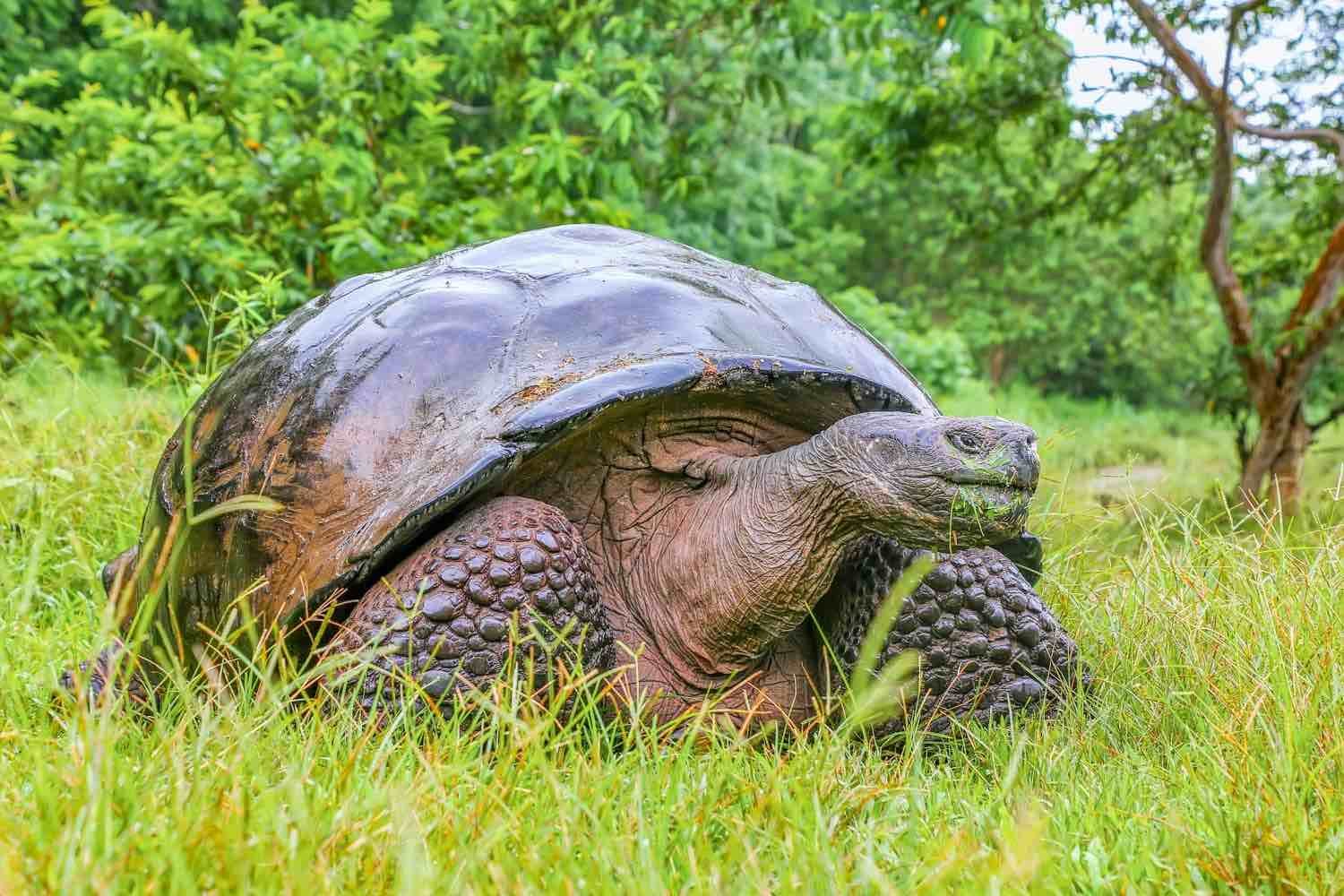
The tubes become covered with earth over time and the result is a perfectly formed underground tunnel courtesy of Mother Nature.
A wooden stairway descends to the mouth of the arched entrance to one of these underground passages and continues to the narrow opening that marks its exit.
There are lights to show you the way but it’s also a good idea to bring a flashlight.
Los Gemelos
The terrestrial world of the tortoise and underworld of the lava tubes meet at Los Gemelos (the twins).
These two large sinkholes craters were formed by collapsed lava tubes.
The contrast between the marine desert coast and verdant Lost World look of the highlands is most striking here and you can easily encounter rain even when sun is shining a half an hour away at the coast.
Endemic Scalesia Forest
Los Gemelos are surrounded by a Scalesia forest. Scalesia is endemic to Galapagos and many endemic and native species call the forest home.
This is an excellent place to view some of Darwin’s famous finches along with the elusive and dazzling vermillion flycatcher.
We return to Puerto Ayora with time for shopping, visiting an internet café or simply enjoying this little port town near the edge of the world.
DAY 4 AT A GLANCE
Morning: Darwin Station / Puerto Ayora
Type of Landing: Dry
Level of Walk: Easy
Other Activities: Nature Hikes
Afternoon: Highlands
Type of Landing: Dry
Level of Walk: Easy
Other Activities: Nature Hikes
Meals: Breakfast, Lunch, & Dinner
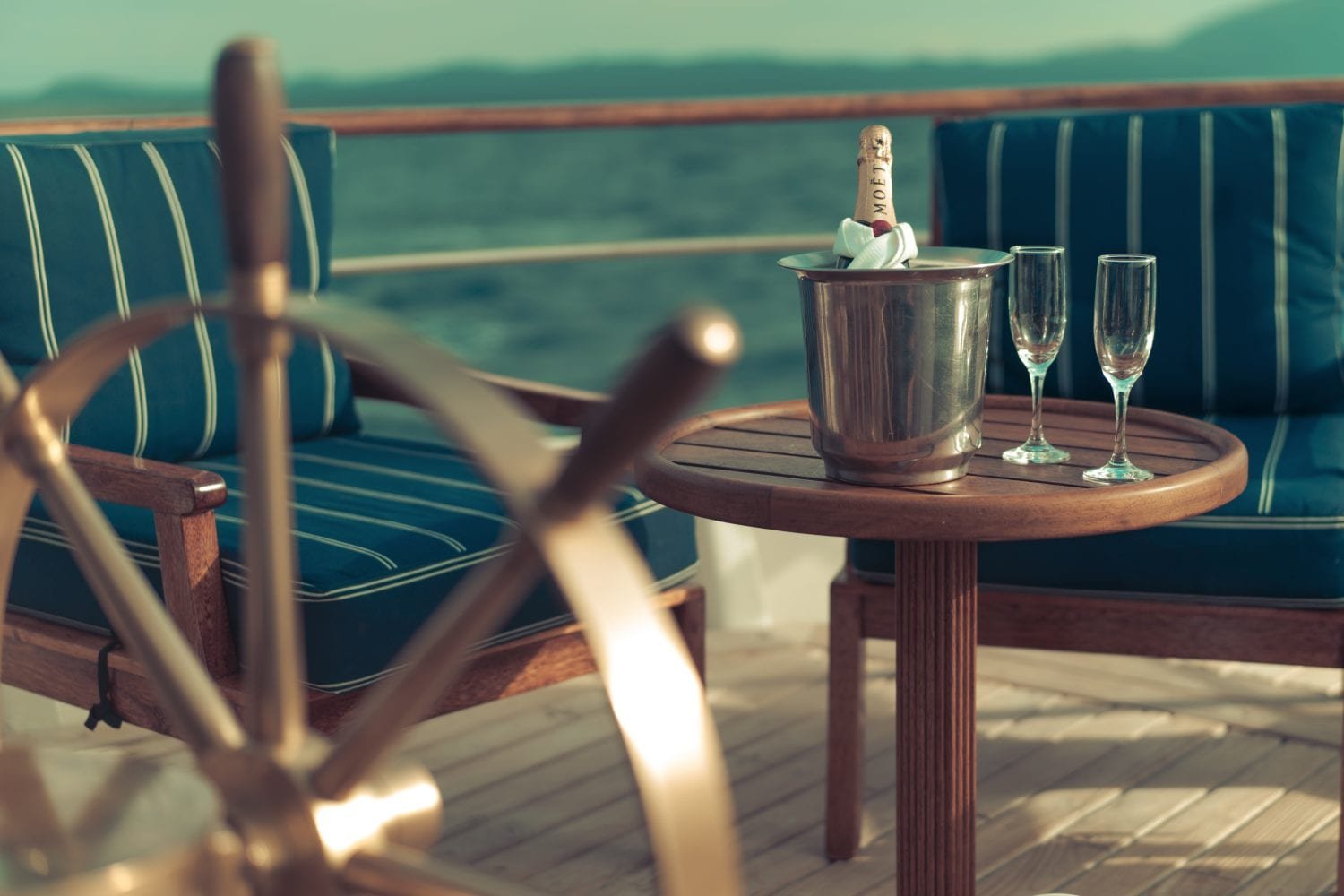
DAY 5 – WEDNESDAY
AM: Playas Las Bachas
PM: Sombrero Chino Island
ACTIVITIES: Snorkeling, Panga Rides, Walks & Hikes and Kayaking
At the north end of Santa Cruz Island is Las Bachas, comprised of two sandy white-coral beaches that is are major egg-laying sites for sea turtles.
The official story of how Las Bachas got its name comes from the Galapagos National Park. During WWII the US military discarded two barges on Santa Cruz’s beaches.
The first settlers to the area following the war mispronounced barges as bachas, resulting the area’s present-day name.
Birding on Santa Cruz: Blue-Footed Boobies and More
We go ashore the white sandy beach and are greeted by patrolling blue-footed boobies.
A brief walk inland takes us to a lagoon where pink flamingos are often found along with great blue herons, common stilts, brown noddys, white-cheek pintail ducks and migratory birds.
Snorkeling today is from the beach and you can also enjoy a swim in these waters which are typically warmer than in other places in the Galapagos.
Sombrero Chino
Tiny Sombrero Chino (Chinese Hat) Island is named for the resemblance its shape has to a traditional Chinese Coolie’s hat.
Our next visitor’s site is off limits to larger groups and day boats, making Sombrero Chino one of the least visited sites in the central islands.
Sombrero Chino lies just off the southeastern tip of the large nearby island of Santiago, separated by a narrow channel which makes for very calm, protected waters.
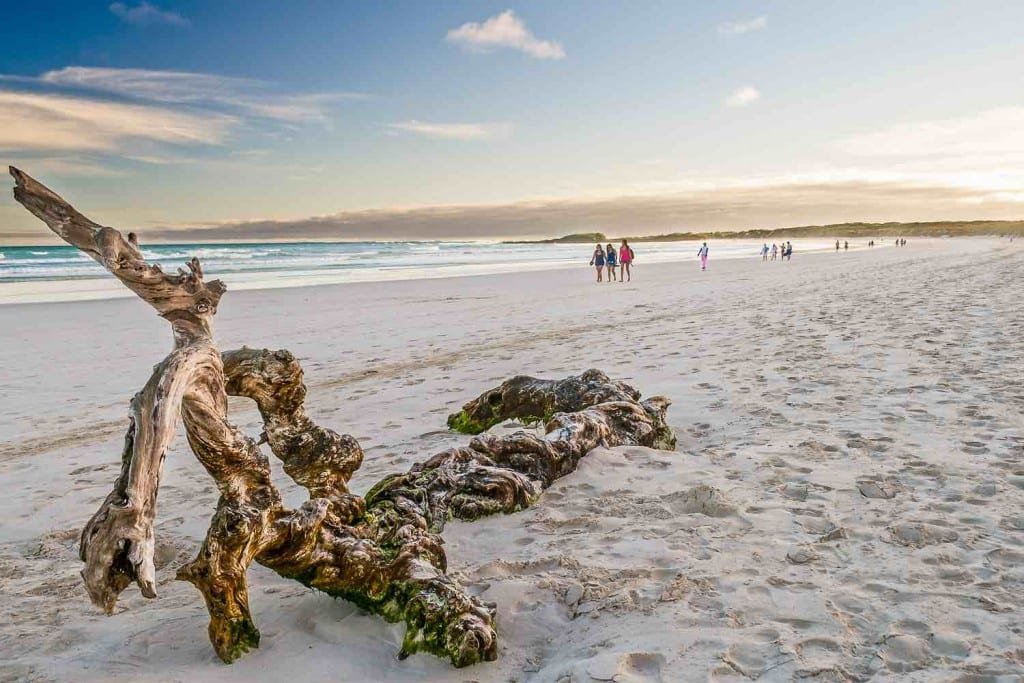
The Grace’s landing site for Sombrero Chino is a tiny crescent shaped cove with sandy white beach cradled between black lava rocks and the crystal turquoise waters of the channel.
A sea lion colony likes to rest on the warm white sands, while the rockier sections of the coast are alive with fiery colored sally lightfoot crabs.
Marine iguanas sun themselves atop the rocks after foraging for algae in the channel.
American oyster catchers stalk the tide pools stabbing at shellfish with their bright orange beaks.
Sombrero Chino’s Volcanic Interior
A quarter mile (400 meter) trail sets off into the island’s volcanic interior to explore its rock formations, including excellent examples of pahoehoe lava resembling black rock ropes.
The area is inhabited by ground hugging red sesuvim plants and curious lava lizards.
Back at the cove you’ll have a chance to snorkel with sea lions.
Notably, rockier sections of the coastline are also inhabited by Galapagos penguins, known to dart past unsuspecting snorkelers.
You’ll also have a chance to see the penguins during a panga ride.
Galapagos penguins are the only species of penguin you’ll find living north of the nearby equator.
DAY 5 AT A GLANCE
Morning: Las Bachas
Type of Landing: Wet
Level of Walk: Easy
Other Activities: Nature Hikes, Snorkeling
Afternoon: Sombrero Chino
Type of Landing: Wet
Level of Walk: Easy
Other Activities: Nature Hikes, Snorkeling, Panga Ride, Kayaking
Meals: Breakfast, Lunch, & Dinner
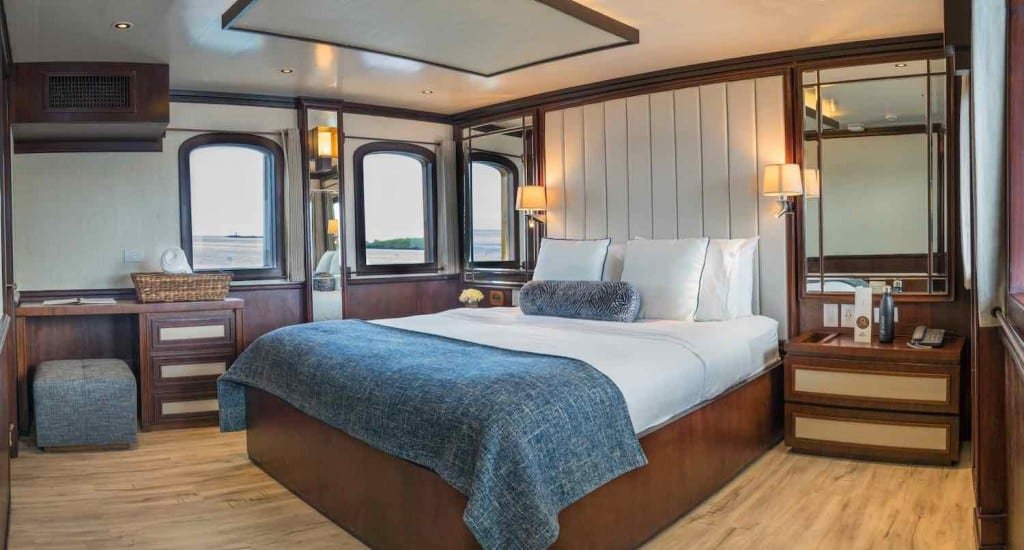
DAY 6 – THURSDAY
AM: Rabida Island
PM: Sullivan Bay
ACTIVITIES: Snorkeling, Walks & hikes, Panga Rides and Kayaking
At the geologic center of the archipelago, Jervis presents an island of a different color with its deep red sandy beach and equally red towering cliffs.
Even the starfish here are red.
Here, the flanks of a sloping volcanic cinder-cone rise sharply from the coast and looking up one can see where the vegetation transitions from the arid zone to the wetter Scaleisia zone.
A hedgerow of green saltbush frames the beach between the clear teal waters of the Pacific making for one of the more colorful islands. A noisy colony of sea lions inhabits these scarlet shores.
Birdwatching: Brown Pelicans, Galapagos Dove, and More
This is also the best place in the islands to get close to nesting brown pelicans raising their chicks in precariously positioned nests atop the saltbush.
A short trail inland offers observations of land birds including Galapagos dove, cactus finch and the large ground-finch.
Hidden behind the narrow strip of green saltbush is a briny lagoon frequented by flamingos.
These large pink birds feed for up to 12 hours a day on the pink shrimp larva and water boatman that give them their color.
We follow the trail to the left and up from the beach to the top of the rocky Rabida peninsula jutting out northward.
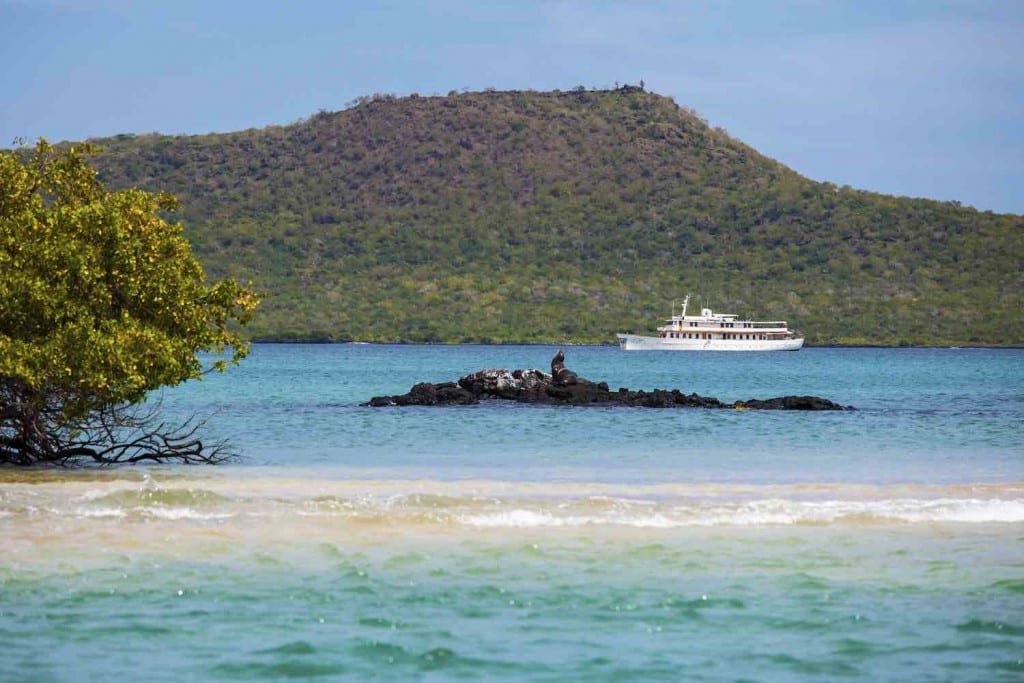
As we climb higher we pass through groves of prickly pear cactus, some oddly reminiscent of Mickey Mouse.
The top of the overlook reveals excellent views back toward the lagoon and red sea cliffs beyond.
Rabida
Rabida also offers a nice kayaking route starting on the eastern side of the peninsula, then around and along it.
The route continues west past the beach, then beneath the island’s towering red cliffs. This is a great place to spot sea turtles from your kayak.
They sometimes swim right up without noticing you and then dart into the depths once they see you.
Make sure you to stop kayaking when you reach the red diamond shaped sign where there is a large rock where both blue footed and masked boobies like to perch.
Snorkeling Off Rabida
Beneath the ocean surface Rabida offers excellent snorkeling along the shore of the little peninsula.
The sea turtles you just saw topside are easier to see once you are in the water. Giant schools of stripped salemas have been seen to carpet the deeper sections, attracting Galapagos sharks.
Large schools of yellow tail surgeon fish thread through passages between the rocks. You can look for chances to swim with sea lions and penguins as well and keep your eyes open for marine iguanas grazing the underwater greenery.
Rare Orca Sightings
We’ve also have had groups watch orca right off the shore on rare occasions but this pod can also be seen elsewhere as they patrol the islands.
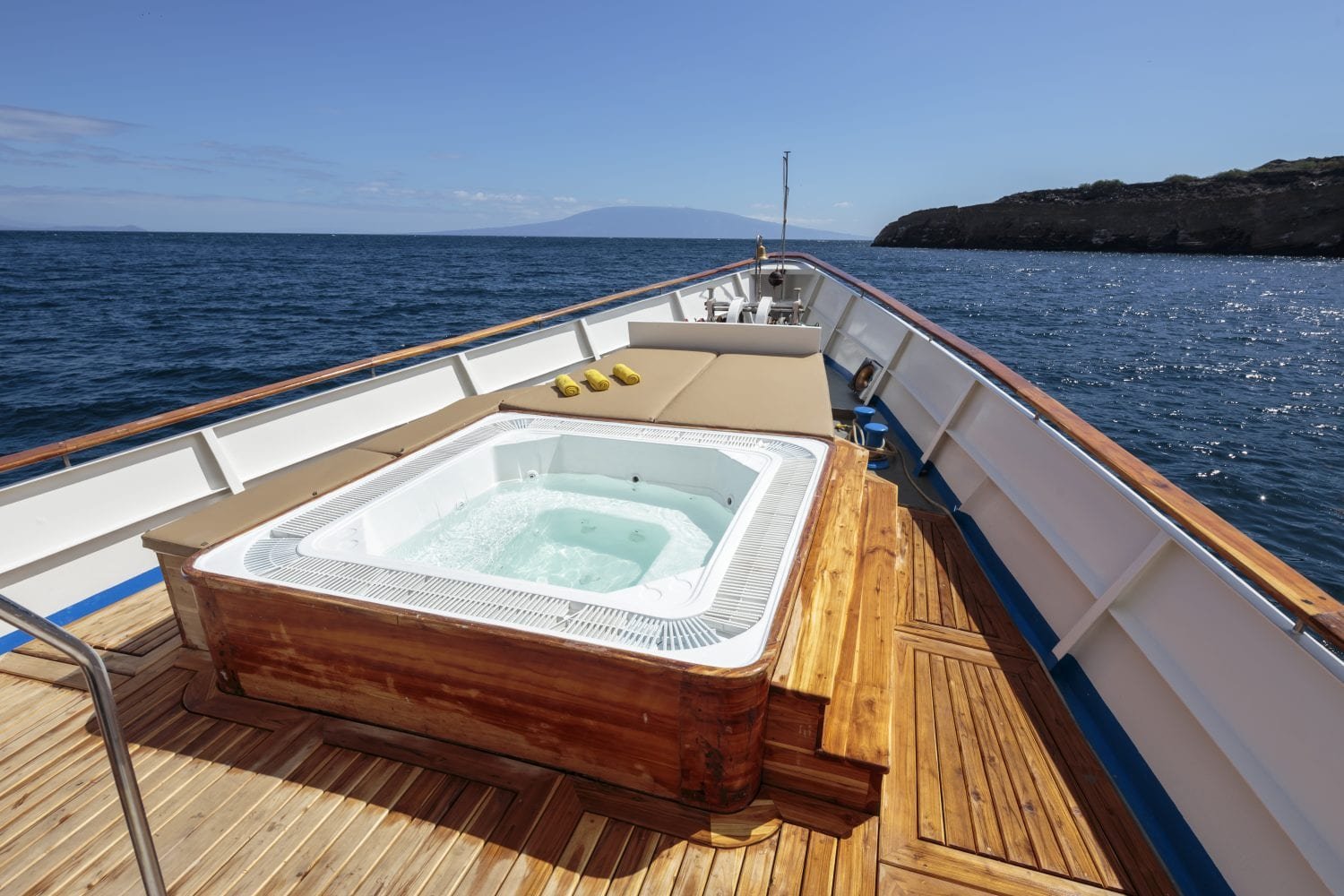
Back aboard the M/Y Grace you’ll have a chance to soak in the hot tub before lunch as we set sail for much larger Santiago Island looming to the north.
We navigate around southeastern shore of Santiago then head north up the coast, entering a channel between Santiago and Bartolome Island.
Pinnacle Rock
We drop anchor in the channel just to the east of the well know Galapagos landmark called Pinnacle Rock. From the M/Y Grace deck, the Pinnacle rock looks a bit like a leaning tower.
Our next landing site is Sullivan Bay, named for the channel in which we are anchored.
If you created a partnership between well know glass artist Dale Chihuly and mother nature the result would be Sullivan Bay.
Back in 1897 the island fired up its own internal kiln giving birth to a field of pahoehoe (“rope-like” in Hawaiian) lava reaching out into the channel toward Bartolome.
The results gleam in the sun like a gigantic, obsidian sculpture.
It stirs the imagination to envision the once-molten lava lighting up the earth, flowing into the sea and sending plumes of superheated steam skyrocketing into the air as pockets of gas in the flow exploded when the lava hit the water.
The flow gave birth to new land as it engulfed vegetation, leaving some plants forever etched into the earth.
Today the flow stands as a great walkway gallery of abstract shapes resembling braids, curtains and swirling fans. Brightly colored painted locusts and lava lizards punctuate the black volcanic canvas, as does the occasional finger of lava cactus and spreading carpetweed.

We hike south into the flow taking time to admire the Earth’s craftwork as we proceed.
Galapagos Penguin Watching
Upon our return to the shore our panga is waiting to take us on a ride along the black rocky coast in search of the Galapagos penguins that dot the shore.
Unlike the penguins, which mimic the lava with their color, sally light foot crabs stand out against the black rocks as a reminder of their once molten state.
The snorkeling along the edge of the lava flow is very good for swimming with penguins and sea lion.
Sunset Over Sullivan Bay
Squadrons of spotted eagle rays pass through the channel, and sea turtle that lay their eggs on nearby Bartolome swim past, while white-tipped reef sharks patrol the bottom.
This evening we’ll watch the sun set over the lava fields of Sullivan Bay as the long rays of the setting sun light up tower-like Pinnacle rock to the east.
This evening will be very quiet, with no need to navigate.
DAY 6 AT A GLANCE
Morning: Rabida Island
Type of Landing: Wet
Level of Walk: Easy
Other Activities: Nature Hikes, Snorkeling, Kayaking & Panga Ride
Afternoon: Sullivan Bay
Type of Landing: Wet
Level of Walk: Moderate
Other Activities: Nature Hikes, Snorkeling
Meals: Breakfast, Lunch, & Dinner
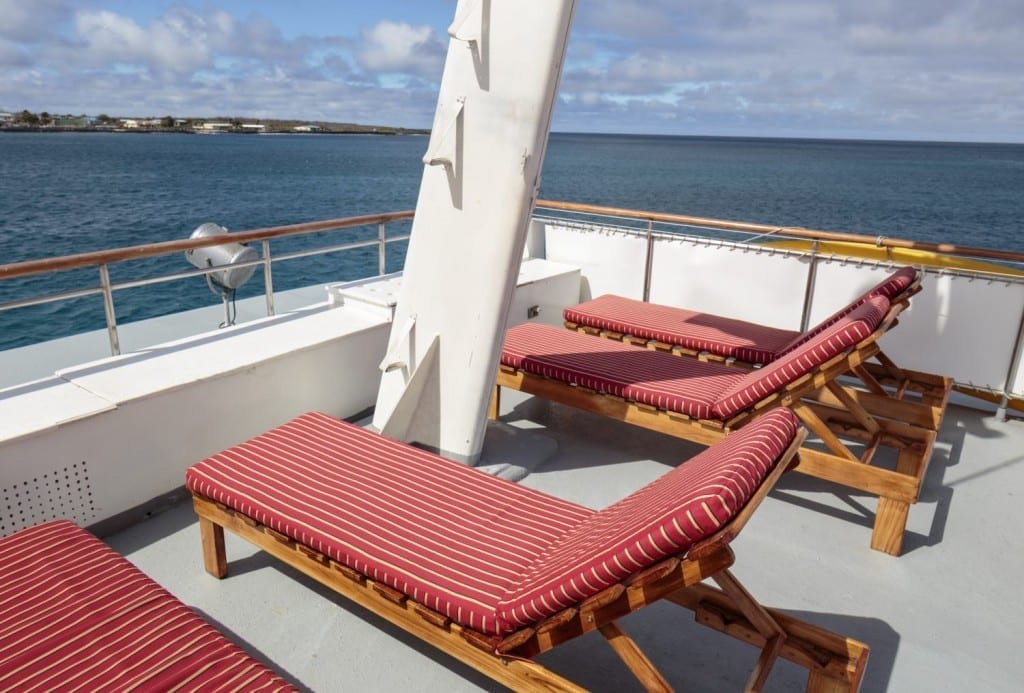
DAY 7 – FRIDAY
AM: Bartolomé Island
PM: North Seymour Island
ACTIVITIES: Snorkeling, Panga Ride, Walks & Hikes
Bartolomé is famous for Pinnacle Rock, a towering spearheaded obelisk that rises from the ocean’s edge
Pinnacle Rock is likely the best known landmark in the Galapagos.
Galapagos penguins the only species of penguin found north of the equator walk precariously along narrow volcanic ledges at its base.
Sea lions snooze on rocky platforms, ready to slide into the water to play with passing snorkelers. Below the surface, shoals of tropical fish dodge in and out of the rocks past urchins, sea stars and anemones.
Sea Turtle Nesting Sites
A perfectly crescent sandy beach lies just to the east of the pinnacle and across a narrow isthmus another beach mirrors this one to the south.
Sea turtles use both beaches and another to the west of the Pinnacle as nesting sites.
Accordingly, they can occasionally be seen wading back out into the shallow water near the shore, or resting in the sand recovering from the arduous task of digging nests, laying eggs and covering them over.
Penguins like to rest atop the nearby rocks by our next landing site, about a quarter mile east along the shore.
Here the submerged walls of a tiny volcanic crater give the impression of a large fountain pool.
Bartolome’s Summit
This dry landing is the entrance to a 600-meter (2000-foot) pathway complete with stairs and boardwalks leading to Bartolome’s summit.
The route is not difficult and presents an open textbook of the islands’ volcanic origins; a site left untouched after its last eruption, where small cones stand in various stages of erosion and lava tubes form bobsled-like runs down from the summit.
At the top you will be rewarded with spectacular views of Santiago Island and Sullivan Bay to the west, and far below, Pinnacle Rock and our beach, where the crystal turquoise waters of the bay cradle the Grace.
Our next landing site is a short distance away to the southeast.
North Seymour Island
North Seymour Island was lifted from the ocean floor by a seismic event, and its origins as a seabed give the island its low, flat profile.
Cliffs only a few meters high form much of the shoreline, where swallow-tailed gulls sit perched in ledges. A tiny forest of silver-grey Palo Santo trees stand just above the landing, usually without leaves, waiting for the rain to bring them into bloom.
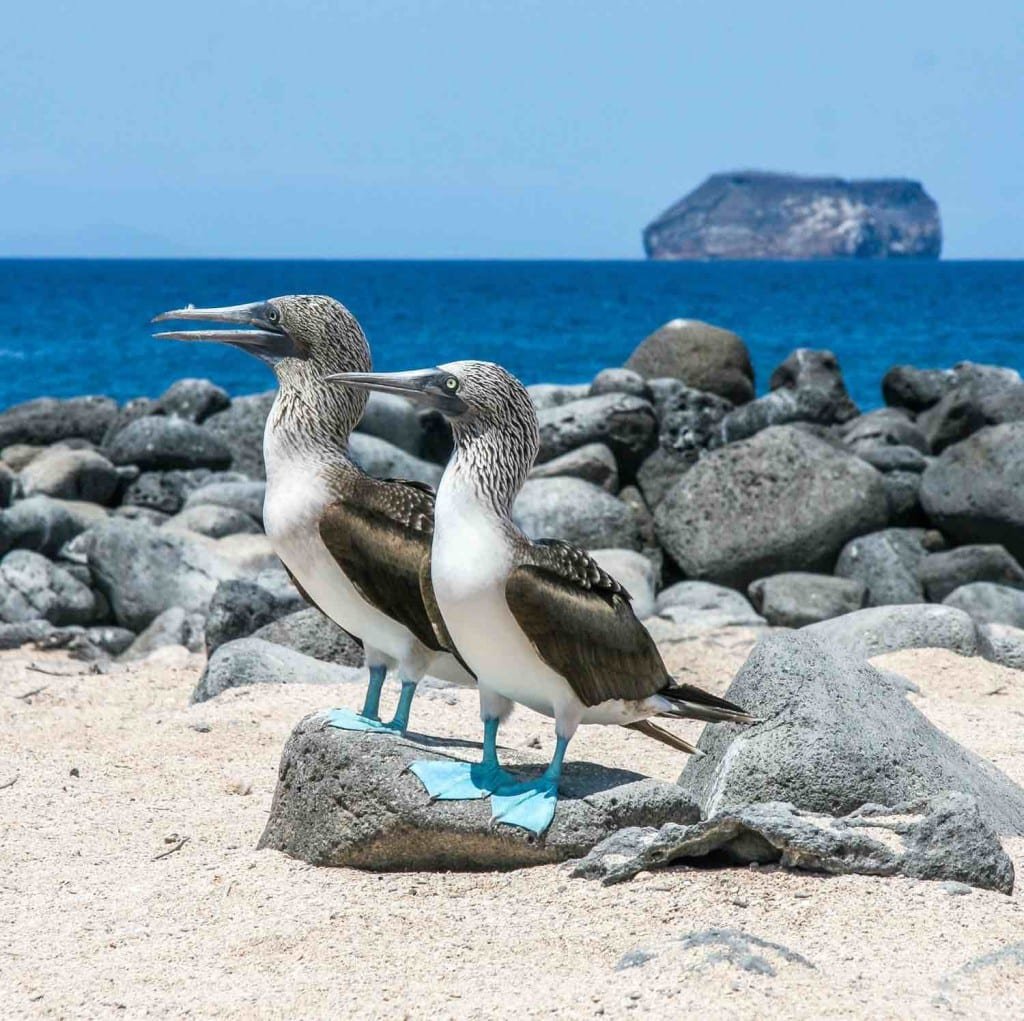
North Seymour is teeming with life!
You might have to give way to a passing sea lion or marine iguana. Blue-footed boobies nest on either side of the trail where mating pairs perform their courtship dance.
You are likely to see fluffy white chicks peeking out from beneath their protective mothers. The trail follows the eastern shore along the beach.
You may be fortunate to witness flocks of brown pelicans and blue-footed boobies hunting schools of fish.
The boobies, which look so comical on land, are ideally adapted as dive bombers and easily pierce the water, zeroing in on their targeted prey.
Frigate Birds
Frigate birds with wingspans of up to 5 feet soar overhead and all around.
They were named for the way that the trim of their wings in flight are reminiscent of the square rigged sailing warship.
Not coincidentally frigate birds are also called Man O’ War birds and they live up to that name in a literal way when they target boobies, pelicans and other birds to steal their catch.
Because the frigates are pelagic, they lack the ability to take off from the water, so they do better at snatching fish from the surface or simply stealing them. They also target marine iguanas and young baby sea turtles.
The trail turns east and inland to reveal the nesting stronghold of the frigates.
Here you can see males with large, bright red, inflated throat sacks known as gular pouches, all done in an effort to attract females.
Your guide will point out the difference between the Magnificent, or Man O’ War frigates and their Great frigate bird cousins.
Large puff-ball frigate bird chicks inhabit nests, waiting for their parents to return with a meal. Even at this young age they possess long hooked beaks and act defiant when they feel threatened.
You will also get a closer look at the feathers of the proud parents and notice their iridescent quality and deep green tinge.
The Yellow Land Iguana
Another inhabitant along the trail is the yellow land iguana.
This species was originally introduced to the North Seymour in 1932 by Captain Alan Hancock and his crew from Baltra with the aim of rescuing the creatures from the poor conditions left by goats and other feral animals.
The yellow land iguanas colonized the island without problem. The original colony disappeared from Baltra when it became a US military base in WWII.
Charles Darwin Station Breeding Program
In 1980 Charles Darwin Station began a breeding program using some of the animals found on Seymour and successfully reintroduced their prodigy to both islands.
Today the population on Seymour is roughly 600 and on Baltra 1,500.
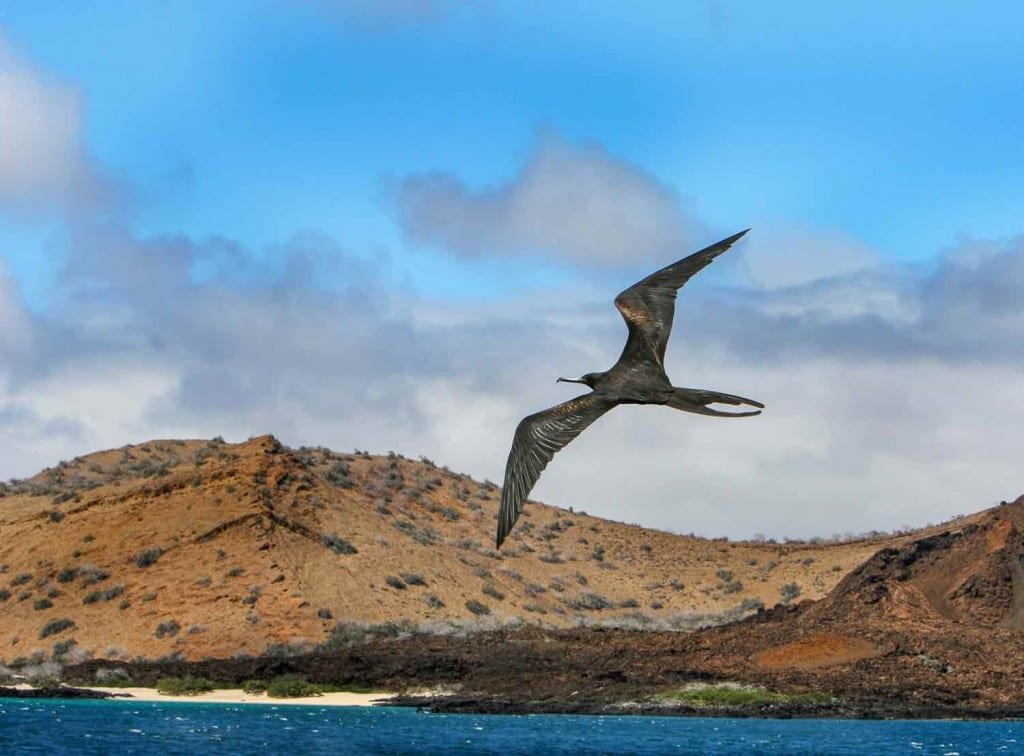
Our snorkeling site at North Seymour also attracts scuba divers. You have a chance to see many types of rays here including:
- Marble Rays
- Golden Eagle Rays
- Spotted Eagle Rays
- Sting Rays
- Manta Rays
Dormitories of white-tipped reef sharks sleep on the bottom while schools of king angelfish and yellow tailed surgeonfish swarm the rocky shoreline passing the occasional parrot and damselfish.
Diverse Oceanlife
Some of the rocks are actually well disguised scorpion fish. Large schools of tightly packed blue and gold snappers, grunts and jacks are usually also found plying these waters.
Sea lions pay visits from both Seymour and nearby Mosquera Island as sea turtles and the occasional hammerhead shark can been seen down in the depths.
Creole fish, the color of red salsa, hieroglyphic hawkfish, with neon-like etchings on their flanks and spotfin burrfish, which look a bit like a swimming shoe box with a cartoon face also inhabit the region.
This evening will be especially relaxed and you can have a long lingering soak in the Jacuzzi.
The M/Y Grace can stay anchored where she is tonight as we are already within sight of our morning’s landing site across the channel just to the south.
The view east toward the tiny twin table mountain islands of Daphne Major and Daphne Minor is particularly inviting with the sun setting behind them.
DAY 7 AT A GLANCE
Morning: Bartolome Island
Type of Landing: Dry
Level of Walk: Moderate
Other Activities: Nature Hikes, Snorkeling & Panga Ride
Late Afternoon: North Seymour Island
Type of Landing: Dry
Level of Walk: Moderate
Other Activities: Nature Hikes & Snorkeling
Meals: Breakfast, Lunch, & Dinner
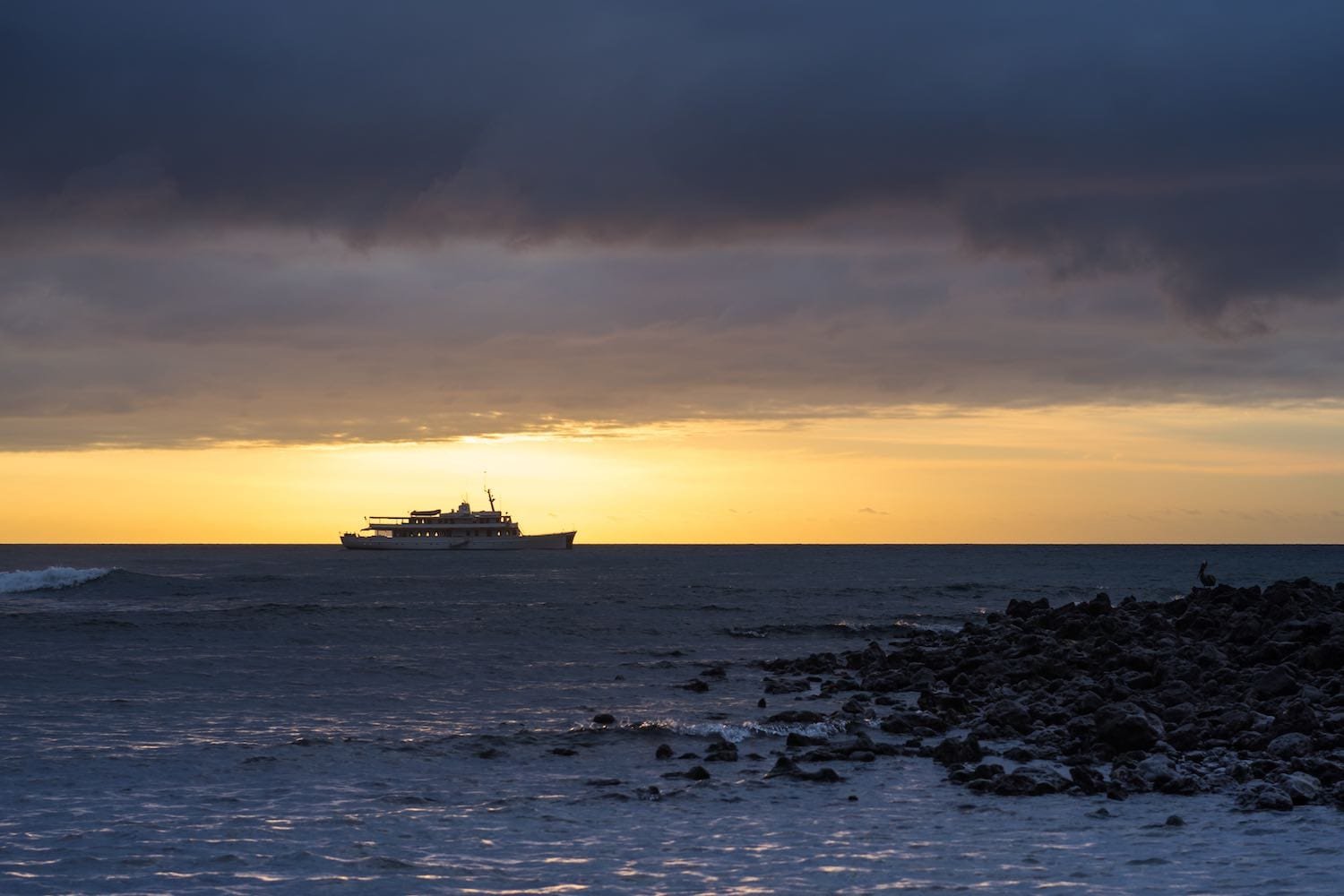
DAY 8 – SATURDAY
AM: Black Turtle Cove / Baltra & Flight Home
ACTIVITIES: Panga Ride
This last morning of our voyage through the Galapagos we visit Black Turtle Cove.
Located on the northern shore of Santa Cruz, the cove is a living illustration of how mangroves alter the marine environment to create a rich and unique habitat.
Four species of mangrove crowd from the shore out into the lagoon, which stretches almost a mile inland.
As we drift through the quiet waters in our dinghy, we are likely to see spotted eagle rays and cow nosed or golden rays, which swim in a diamond formation.
“Turtle Sanctuary Cove”
White-tipped reef sharks can be seen beneath the boat and Pacific green sea turtles come to the surface for air and to mate.
Sea birds, including brown pelicans, blue herons and lava herons, come to feed in the cove which has also been declared a “Turtle Sanctuary”.
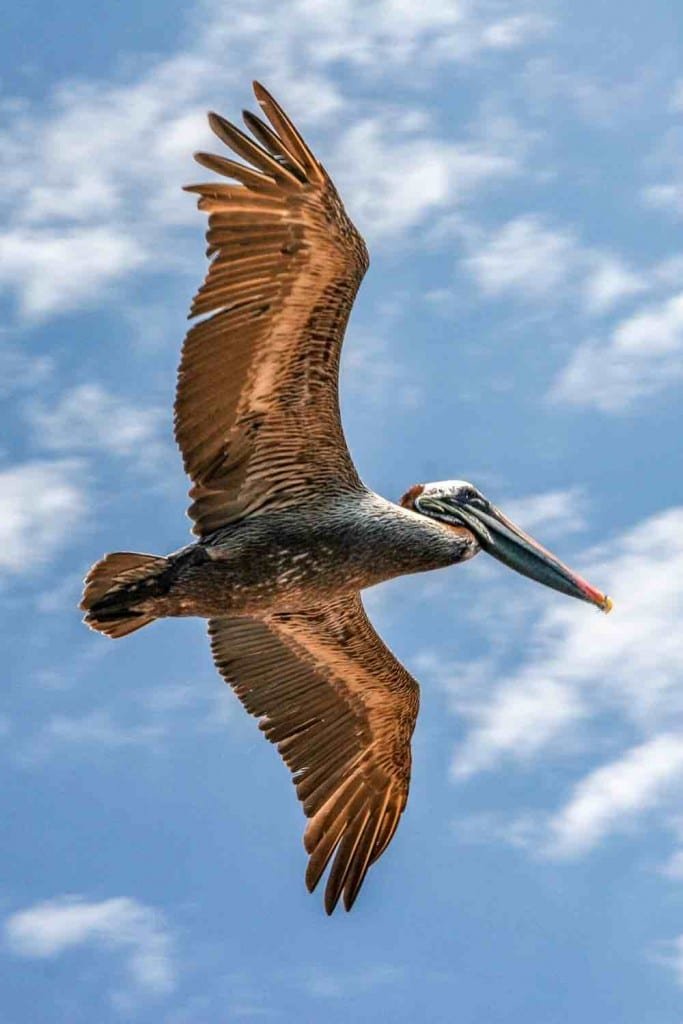
Baltra Island
It’s time to begin your journey home as we set sail for nearby the Baltra Island.
It doesn’t take long for the Evolution to navigate north along Baltra’s western shore to the island’s port.
Don’t worry about your bags, your guide will instruct you on how to prepare your luggage and have it ready for pick up in your cabin.
Our crew will see to transporting your luggage ashore where you will reunite with it at the airport.
All you need to do is take along your carryon luggage in the panga for the short crossing to shore. Once there a bus will pick us up for the 5 minute drive to the airport.
Your guide will be there to make sure you are checked in on the proper flight.
There is one final check point before you enter the waiting area from which you will board your flight.
Farewell to the Galapagos
Almost all flights to the mainland stop in Guayaquil and continue on to Quito so make sure you know where to get off the plane.
We say farewell to the Galapagos as you begin your journey home, or on to other destinations like the Ecuadorian highlands, Amazon or nearby Peru.
DAY 8 AT A GLANCE
Morning: Black Turtle Cove
Type of Landing: N/A
Other Activities: Panga
Late Morning: Return to Mainland Ecuador
Meals: Breakfast
Group-basis cruises depart each Saturday for eight days and seven nights.
The Grace can also be chartered for private Galapagos cruises, allowing guests to customize their cruise itineraries.
Cruises on the Grace can also be combined with land-based extensions.

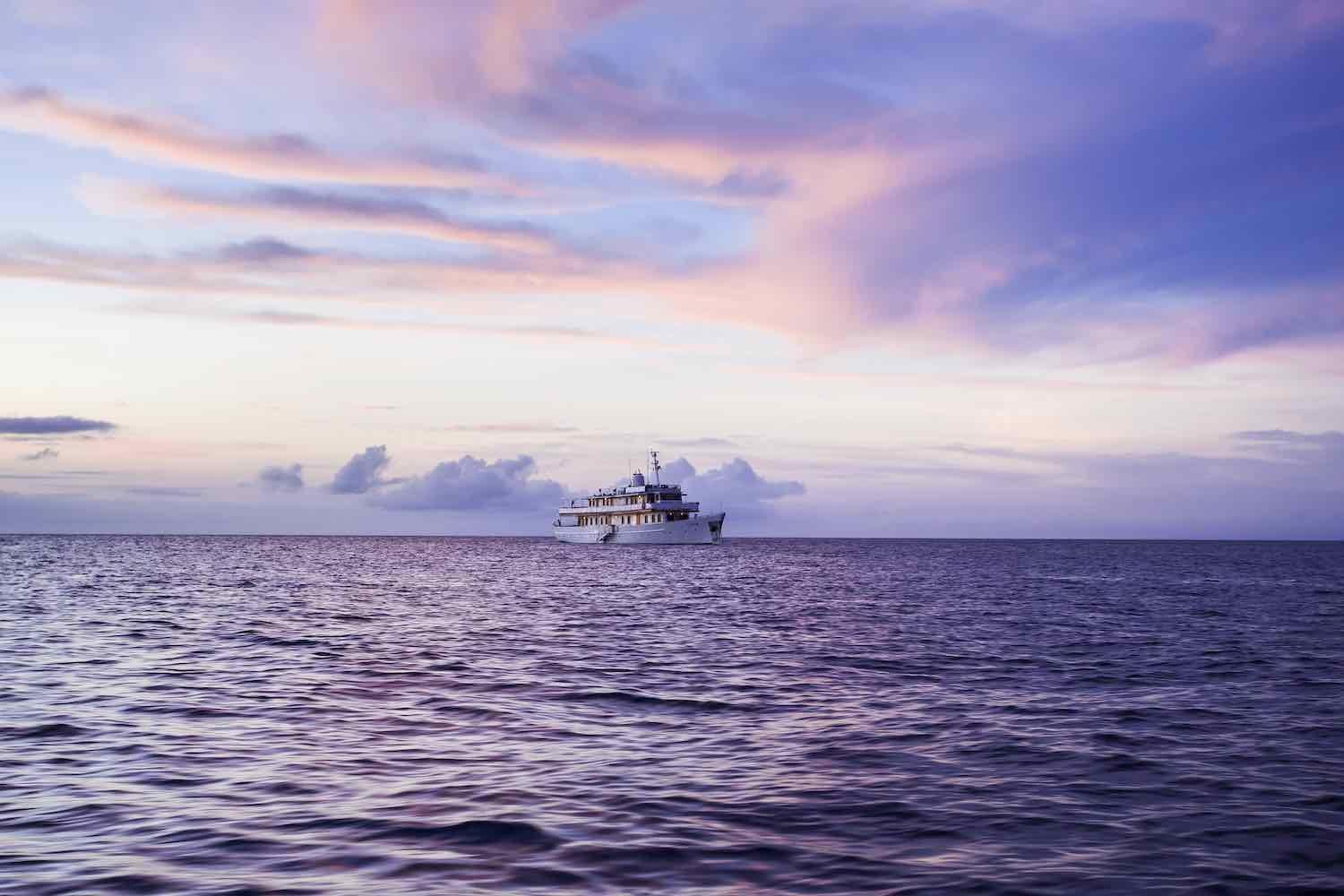
LANDED arranges cruises aboard and private charter of the Grace, as well as air travel, land transportation, tours and accommodations in mainland Ecuador. Speak with a travel consultant today at 801.582.2100. We’ll take care of the details.
